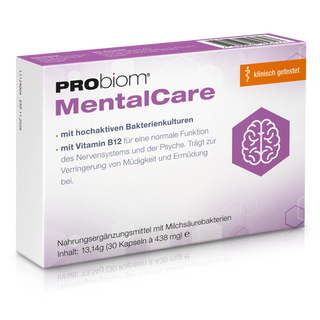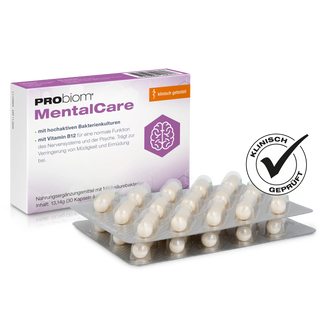Antibiotics are a blessing of modern medicine. They have saved countless lives and are prescribed millions of times around the world. However, many people report that their symptoms initially worsen after starting antibiotic therapy – rather than improve. This phenomenon, often described as the "initial worsening" after antibiotics , is unsettling for those affected and raises many questions.
In this article, we'll explain exactly what causes initial exacerbation after taking antibiotics , why it occurs, what role your microbiome plays in this, and how you can best support your body during this phase. You'll receive in-depth information, practical tips, and suggestions for natural remedies to restore balance in your body.
What does initial worsening mean with antibiotics?
An initial exacerbation describes a temporary worsening of symptoms that can occur shortly after starting treatment—in this case, taking antibiotics. This can worsen existing symptoms or cause new ones to appear.
Typical symptoms of initial worsening after antibiotics:
-
Increased tiredness or fatigue
-
Headache
-
Skin rashes or itching
-
Digestive problems such as diarrhea or flatulence
-
Intensification of the original infection symptoms (e.g. cough, pain)
Important: An initial worsening of symptoms does not necessarily mean that the medication isn't working or that something is wrong. In many cases, it's a sign that the body is responding and preparing for a healing process.
Why can symptoms initially worsen after taking antibiotics?
The causes of initial exacerbation after taking antibiotics are complex. Here are the most common explanations:
1. Death of bacteria and release of toxins
Antibiotics kill bacteria—that's their primary function. However, when pathogens die en masse, they also release toxins that place additional strain on the immune system. This so-called Herxheimer reaction can lead to a short-term deterioration.
2. Disruption of the microbiome
The microbiome —especially in the gut—consists of trillions of bacteria that perform important functions for our health. Antibiotics usually don't distinguish between "good" and "bad" bacteria. The result:
-
The diversity of the microbiome decreases
-
Dysbiosis occurs (imbalance)
-
Pathogenic germs such as Candida albicans can spread
-
The intestinal mucosa becomes more susceptible to inflammation
These changes can manifest themselves in symptoms such as bloating, diarrhea, feeling of fullness, cravings for sugar or even mood swings – typical signs of a microbial imbalance.
3. Overreaction of the immune system
When pathogens die, the immune system responds by producing inflammatory mediators . In people with a sensitive immune system, this reaction can be exaggerated —which is perceived as an initial exacerbation.
4. Candida overgrowth after antibiotics
Because antibiotics also reduce the protective lactic acid bacteria in the intestines, fungal overgrowth , particularly Candida, often occurs. This can cause various symptoms, including:
-
White deposits in the mouth
-
Vaginal yeast infection
-
Fatigue, brain fog
-
Skin problems
Many people do not notice this connection immediately, but the initial worsening is often an early sign of an emerging fungal problem .
Difference between initial worsening and side effect?
It is important to distinguish between a natural reaction of the body and a genuine adverse drug reaction .
Typical initial worsening:
-
Usually begins 1–3 days after starting antibiotics
-
Symptoms are temporary (approx. 3–7 days)
-
General condition usually remains stable
Possible side effects:
-
Allergic reactions (rash, shortness of breath, swelling)
-
Severe gastrointestinal complaints
-
Liver or kidney damage
-
Fungal infections caused by dysbiosis
Note: If you experience severe symptoms or are unsure about anything, always consult a doctor . An initial worsening should never be used as an excuse to ignore serious side effects.
The microbiome in focus: How antibiotics disrupt the balance in the gut
The human microbiome is a fascinating ecosystem of microorganisms that:
-
Support digestion
-
Regulate the immune system
-
produce vitamins
-
Protect the intestinal mucosa
A healthy microbiome acts as a natural protective barrier against pathogens. But antibiotics massively attack this system—even with short-term use.
Consequences of microbiome disruption:
-
Digestive problems (bloating, diarrhea, irritable bowel syndrome)
-
Immune deficiency (frequent infections, allergies)
-
Mood swings , as intestinal bacteria influence neurotransmitters such as serotonin
-
Long-term susceptibility to disease (e.g., autoimmune diseases, metabolic syndrome)
Conclusion: A disturbed intestinal flora is not just a cosmetic problem—it affects our health on many levels. This makes it all the more important to specifically support the microbiome , especially during and after antibiotic therapy.
What to do if symptoms worsen after taking antibiotics?
1. Keep calm and observe
Mild discomfort during the first few days is common and usually not cause for concern. It's important to monitor the condition and seek medical advice if the condition worsens significantly.
2. Use probiotics specifically
Taking high-quality probiotics can help restore balance in the gut. Recommended supplements include:
-
Lactobacillus acidophilus
-
Bifidobacterium bifidum
-
Saccharomyces boulardii (particularly effective for antibiotic-induced diarrhea)
Tip: Probiotics should ideally be taken at a later time than antibiotics (at least 2-3 hours later) to avoid impairing their effectiveness.
3. Adjust your diet
If possible, avoid the following during and after antibiotic therapy:
-
Sugar and white flour
-
alcohol
-
highly processed foods
Instead, focus on:
-
Fermented foods (e.g. sauerkraut, kefir, kimchi)
-
Vegetables, fiber and healthy fats
-
Bone broth and herbal teas for intestinal cleansing
4. Support liver and detoxification
The liver plays a central role in the disposal of bacterial toxins and drug residues. Helpful measures:
-
Bitter substances (e.g. milk thistle, artichoke)
-
Drink plenty of water
-
Get enough sleep
-
Moderate exercise
5. Prevent fungal overgrowth
Since Candida often attacks after the administration of antibiotics, a prophylactic fungal treatment with oregano oil, caprylic acid or grapefruit seed extract can be useful – ideally under medical or naturopathic supervision.
How long does the initial worsening after antibiotics last?
The duration depends heavily on individual factors:
-
Type and dose of antibiotic
-
Initial state of the microbiome
-
General immune status
-
Diet and lifestyle
An initial worsening usually subsides after a few days. However, if it persists for more than a week , further measures should be initiated and medical evaluation should be sought.
Conclusion: Initial worsening after antibiotics is not a reason to panic – but a sign to act
An initial worsening of symptoms after taking antibiotics is not uncommon and often indicates that the body is undergoing intensive cleansing and regulatory processes . Nevertheless, you should take symptoms seriously and consciously counteract them – especially by strengthening your microbiome .
With probiotics , a gut-friendly diet, natural detox aids and a mindful lifestyle, you can help your body get back into balance – and avoid long-term consequences.


















